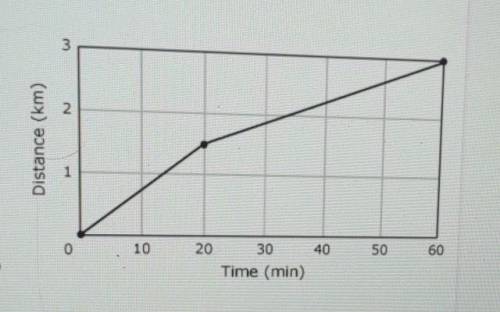
Physics, 12.02.2021 22:20 hannahbaak
PLEASE HELP I CANT FAIL. PLEASE. THANK YOU. The graph to the right shows distance over time. Which of these situations could be represented by this graph?
A) Distance (km) A A student walks 1.5 km to a friend's house in 20 minutes. The two students then walk another 1.5 km to school in 40 minutes.
B) A student walks 1.5 km to a friend's house in 40 0 20 30 minutes. The two students then walk another 1.5 km to Time (min) school in 20 minutes.
C) A student walks 1.5 km to a friend's house in 30 minutes. The two students then walk another 1.5 km to school in 30 minutes.
D) A student walks 1.5 km to a friend's house in 20 minutes. The two students then walk another 1.5 km to school in 60 minutes. 10 40 50 60 DO


Answers: 3


Other questions on the subject: Physics


Physics, 22.06.2019 03:40, srtero
Aprojectile is launched from ground level with an initial velocity of v 0 feet per second. neglecting air resistance, its height in feet t seconds after launch is given by s equals negative 16 t squared plus v 0 t. find the time(s) that the projectile will (a) reach a height of 192 ft and (b) return to the ground when v 0equals112 feet per second. (a) find the time(s) that the projectile will reach a height of 192 ft when v 0equals112 feet per second. select the correct choice below and, if necessary, fill in the answer box to complete your choice.
Answers: 1


Physics, 22.06.2019 20:50, dorkygirl
An ideal otto cycle has a compression ratio of 8. at the beginning of the compression process, air is at 95 kpa and 27°c, and 750 kj/kg of heat is transferred to air during the constant-volume heat-addition process. assuming constant specific heats at room temperature, determine (a) the pressure and temperature at the end of the heat-addition process, (b) the net work output, (c) the thermal efficiency, and (d) the mean effective pressure for the cycle. (4390 kpa, 1730 k; 423 kj/kg; 56.4%; 534 kpa)
Answers: 1
You know the right answer?
PLEASE HELP I CANT FAIL. PLEASE. THANK YOU. The graph to the right shows distance over time. Which o...
Questions in other subjects:

Mathematics, 06.01.2021 20:20


Mathematics, 06.01.2021 20:20

Mathematics, 06.01.2021 20:20

Physics, 06.01.2021 20:20

Geography, 06.01.2021 20:20

English, 06.01.2021 20:20

Mathematics, 06.01.2021 20:20

Mathematics, 06.01.2021 20:20



